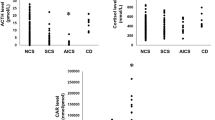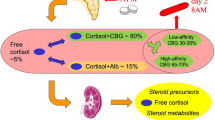Abstract
Introduction
Diagnosing Cushing’s syndrome (CS) can be a challenge, especially in ACTH-dependent CS, when it comes to detecting the origin of ACTH secretion.
Materials and methods
Retrospective data were collected on 170 patients with ACTH-dependent CS (149 CD, 21 EAS) referring to two endocrinology units, focusing on three non-invasive tests: dexamethasone 8 mg overnight challenge (HDDST); corticotrophin-releasing hormone (CRH) assay and the desmopressin (DDAVP) test.
Results
Patients with EAS were slightly older and had higher ACTH, serum and urinary cortisol levels than patients with CD (p < 0.01). CD patients had a stronger ACTH and cortisol response after CRH injection (p < 0.0001), and a more pronounced reduction in cortisol levels after HDDST (p < 0.0001). A threshold percentage ACTH increase after CRH stimulation of 72.4 % was able to identify CD with a sensitivity (SE) of 76 % (95 % CI 68–83) and a specificity (SP) of 100 % (95 % CI 83–100). As for HDDST, a cortisol suppression >52.7 % below the basal level suggested a pituitary origin with a SE of 88 % (95 % CI 81–93) and a SP of 90 % (95 % CI 68–99). There were no cases of EAS with positive responses to both these tests. Increases in ACTH and cortisol levels after the DDAVP test were also higher in CD than in EAS (p < 0.01), though the SE and SP were lower.
Conclusions
Patients with CD showed a stronger response to HDDST and CRH, and the adopted cut-offs showed a good SE and SP in discriminating them from patients with EAS. Concordant tests indicated CD when positive, whereas no response to either test was highly suggestive of EAS. The DDAVP test was of limited utility in the diagnostic phase. In conclusion, the choice of tests may play an important part in the differential diagnosis of ACTH-dependent CS.



Similar content being viewed by others
References
Newell-Price J, Bertagna X, Grossman AB, Nieman LK (2006) Cushing’s syndrome. Lancet 367(9522):1605–1617
Nieman LK, Biller BM, Findling JW, Newell-Price J, Savage MO, Stewart PM, Montori VM (2008) The diagnosis of Cushing’s syndrome: an endocrine society clinical practice guideline. J Clin Endocrinol Metab 93(5):1526–1540
Boscaro M, Arnaldi G (2009) Approach to the patient with possible Cushing’s syndrome. J Clin Endocrinol Metab 94(9):3121–3131
Obuobie K, Davies JS, Ogunko A, Scanlon MF (2000) Venous thrombo-embolism following inferior petrosal sinus sampling in Cushing’s disease. J Endocrinol Invest 23(8):542–544
Lefournier V, Gatta B, Martinie M, Vasdev A, Tabarin A, Bessou P, Berge J, Bachelot I, Chabre O (1999) One transient neurological complication (sixth nerve palsy) in 166 consecutive inferior petrosal sinus samplings for the etiological diagnosis of Cushing’s syndrome. J Clin Endocrinol Metab 84(9):3401–3402
Bonelli FS, Huston J 3rd, Meyer FB, Carpenter PC (1999) Venous subarachnoid hemorrhage after inferior petrosal sinus sampling for adrenocorticotropic hormone. AJNR Am J Neuroradiol 20(2):306–307
Kola B, Grossman AB (2008) Dynamic testing in Cushing’s syndrome. Pituitary 11(2):155–162
Alexandraki KI, Grossman AB (2010) The ectopic ACTH syndrome. Rev Endocr Metab Disord 11(2):117–126
Ilias I, Torpy DJ, Pacak K, Mullen N, Wesley RA, Nieman LK (2005) Cushing’s syndrome due to ectopic corticotropin secretion: twenty years’ experience at the National Institutes of Health. J Clin Endocrinol Metab 90(8):4955–4962
Reimondo G, Paccotti P, Minetto M, Termine A, Stura G, Bergui M, Angeli A, Terzolo M (2003) The corticotrophin-releasing hormone test is the most reliable noninvasive method to differentiate pituitary from ectopic ACTH secretion in Cushing’s syndrome. Clin Endocrinol (Oxf) 58(6):718–724
Suda T, Kageyama K, Nigawara T, Sakihara S (2009) Evaluation of diagnostic tests for ACTH-dependent Cushing’s syndrome. Endocr J 56(3):469–476
Luque RM, Ibáñez-Costa A, López-Sánchez LM, Jiménez-Reina L, Venegas-Moreno E, Gálvez MA, Villa-Osaba A, Madrazo-Atutxa AM, Japón MA, de la Riva A, Cano DA, Benito-López P, Soto-Moreno A, Gahete MD, Leal-Cerro A, Castaño JP (2013) A cellular and molecular basis for the selective desmopressin-induced ACTH release in Cushing disease patients: key role of AVPR1b receptor and potential therapeutic implications. J Clin Endocrinol Metab 98(10):4160–4169
Tsagarakis S, Tsigos C, Vasiliou V, Tsiotra P, Kaskarelis J, Sotiropoulou C, Raptis SA, Thalassinos N (2002) The desmopressin and combined CRH-desmopressin tests in the differential diagnosis of ACTH-dependent Cushing’s syndrome: constraints imposed by the expression of V2 vasopressin receptors in tumors with ectopic ACTH secretion. J Clin Endocrinol Metab 87(4):1646–1653
Barbot M, Albiger N, Koutroumpi S, Ceccato F, Frigo AC, Manara R, Fassina A, Gardiman MP, Scanarini M, Mantero F, Scaroni C (2013) Predicting late recurrence in surgically treated patients with Cushing’s disease. Clin Endocrinol (Oxf) 79(3):394–401
Arnaldi G, Angeli A, Atkinson AB, Bertagna X, Cavagnini F, Chrousos GP, Fava GA, Findling JW, Gaillard RC, Grossman AB, Kola B, Lacroix A, Mancini T, Mantero F, Newell-Price J, Nieman LK, Sonino N, Vance ML, Giustina A, Boscaro M (2003) Diagnosis and complications of Cushing’s syndrome: a consensus statement. J Clin Endocrinol Metab 88(12):5593–5602
Aron DC, Raff H, Findling JW (1997) Effectiveness versus efficacy: the limited value in clinical practice of high-dose dexamethasone suppression testing in the differential diagnosis of adrenocorticotropin-dependent Cushing’s syndrome. J Clin Endocrinol Metab 82(6):1780–1785
Aytug S, Laws ER Jr, Vance ML (2012) Assessment of the utility of the high-dose dexamethasone suppression test in confirming the diagnosis of Cushing disease. Endocr Pract 18(2):152–157
Isidori AM, Kaltsas GA, Mohammed S, Morris DG, Jenkins P, Chew SL, Monson JP, Besser GM, Grossman AB (2003) Discriminatory value of the low-dose dexamethasone suppression test in establishing the diagnosis and differential diagnosis of Cushing’s syndrome. J Clin Endocrinol Metab 88(11):5299–5306
Newell-Price J, Morris DG, Drake WM, Korbonits M, Monson JP, Besser GM, Grossman AB (2002) Optimal response criteria for the human CRH test in the differential diagnosis of ACTH-dependent Cushing’s syndrome. J Clin Endocrinol Metab 87(4):1640–1645
Pecori Giraldi F, Invitti C, Cavagnini F (2001) Study Group of the Italian Society of Endocrinology on the Pathophysiology of the Hypothalamic-pituitary-adrenal axis. The corticotropin-releasing hormone test in the diagnosis of ACTH-dependent Cushing’s syndrome: a reappraisal. Clin Endocrinol (Oxf) 54(5):601–607
Ritzel K, Beuschlein F, Berr C, Osswald A, Reisch N, Bidlingmaier M, Schneider H, Honegger J, Geyer LL, Schopohl J, Reincke M (2015) ACTH after 15 min distinguishes between Cushing’s disease and ectopic Cushing’s syndrome: a proposal for a short and simple CRH test. Eur J Endocrinol 173(2):197–204
Malerbi DA, Mendonça BB, Liberman B, Toledo SP, Corradini MC, Cunha-Neto MB, Fragoso MC, Wajchenberg BL (1993) The desmopressin stimulation test in the differential diagnosis of Cushing’s syndrome. Clin Endocrinol (Oxf) 38(5):463–472
Findling JW, Raff H (1999) Newer diagnostic techniques and problems in Cushing’s disease. Endocrinol Metab Clin North Am 28(1):191–210
Castinetti F, Morange I, Dufour H, Jaquet P, Conte-Devolx B, Girard N, Brue T (2007) Desmopressin test during petrosal sinus sampling: a valuable tool to discriminate pituitary or ectopic ACTH-dependent Cushing’s syndrome. Eur J Endocrinol 157(3):271–277
Tirabassi G, Faloia E, Papa R, Furlani G, Boscaro M, Arnaldi G (2010) Use of the desmopressin test in the differential diagnosis of pseudo-Cushing state from Cushing’s disease. J Clin Endocrinol Metab 95(3):1115–1122
Valéro R, Vallette-Kasic S, Conte-Devolx B, Jaquet P, Brue T (2004) The desmopressin test as a predictive factor of outcome after pituitary surgery for Cushing’s disease. Eur J Endocrinol 151(6):727–733
Losa M, Bianchi R, Barzaghi R, Giovanelli M, Mortini P (2009) Persistent adrenocorticotropin response to desmopressin in the early postoperative period predicts recurrence of Cushing’s disease. J Clin Endocrinol Metab 94(9):3322–3328
Romanholi DJ, Machado MC, Pereira CC, Danilovic DS, Pereira MA, Cescato VA, Cunha Neto MB, Musolino NR, de Mendonça BB, Salgado LR (2008) Role for postoperative cortisol response to desmopressin in predicting the risk for recurrent Cushing’s disease. Clin Endocrinol (Oxf) 69(1):117–122
Terzolo M, Reimondo G, Alì A, Borretta G, Cesario F, Pia A, Paccotti P, Angeli A (2001) The limited value of the desmopressin test in the diagnostic approach to Cushing’s syndrome. Clin Endocrinol (Oxf) 54(5):609–616
Newell-Price J, Perry L, Medbak S, Monson J, Savage M, Besser M, Grossman A (1997) A combined test using desmopressin and corticotropin-releasing hormone in the differential diagnosis of Cushing’s syndrome. J Clin Endocrinol Metab 82(1):176–181
Salgado LR, Fragoso MC, Knoepfelmacher M, Machado MC, Domenice S, Pereira MA, de Mendonça BB (2006) Ectopic ACTH syndrome: our experience with 25 cases. Eur J Endocrinol 155(5):725–733
Vilar L, Freitas MC, Naves LA, Canadas V, Albuquerque JL, Botelho CA, Egito CS, Arruda MJ, Silva LM, Arahata CM, Agra R, Lima LH, Azevedo M, Casulari LA (2008) The role of non-invasive dynamic tests in the diagnosis of Cushing’s syndrome. J Endocrinol Invest 31(11):1008–1013
Pecori Giraldi F, Cavallo LM, Tortora F, Pivonello R, Colao A, Cappabianca P, Mantero F, on behalf of the Altogether to Beat Cushing’s Syndrome Group (2015) The role of inferior petrosal sinus sampling in ACTH-dependent Cushing’s syndrome: review and joint opinion statement by members of the Italian Society for Endocrinology, Italian Society for Neurosurgery, and Italian Society for Neuroradiology. Neurosurg Focus 38(2):E5
Invitti C, Pecori Giraldi F, de Martin M, Cavagnini F (1999) Diagnosis and management of Cushing’s syndrome: results of an Italian multicentre study. Study Group of the Italian Society of Endocrinology on the Pathophysiology of the hypothalamic–pituitary–adrenal axis. J Clin Endocrinol Metab 84(2):440–448
Funding
This research received no specific Grants from any funding agency in the public, commercial or not-for-profit sector.
Author information
Authors and Affiliations
Corresponding author
Ethics declarations
Conflict of interest
None of the authors have any conflict of interest to disclose relating to this paper.
Rights and permissions
About this article
Cite this article
Barbot, M., Trementino, L., Zilio, M. et al. Second-line tests in the differential diagnosis of ACTH-dependent Cushing’s syndrome. Pituitary 19, 488–495 (2016). https://doi.org/10.1007/s11102-016-0729-y
Published:
Issue Date:
DOI: https://doi.org/10.1007/s11102-016-0729-y




